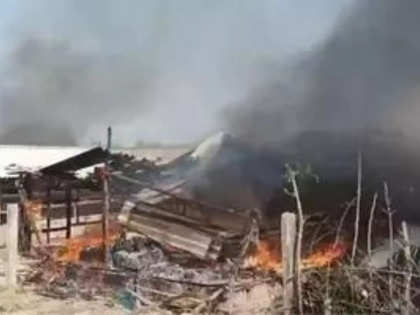 IANS
IANSOn Saturday, poll-going Kolkata was supposed to be a world away from the districts that have, over the last not-so-few election weeks, experienced violence, intimidation, and worse that seem to be standard operating procedure in the run-up to and during polls at every level municipal upwards.
But the bubble of Kolkata, too, has been ‘West Bengal-icised’. Upmarket Ballygunge, for instance, the epitome of bhadralok-ness, was also not spared on polling day.
A cricket ball throw away from the venerable Calcutta Cricket and Football Club (CCFC) – the second oldest cricket club in the world after MCC, where its members will be sporting G&Ts again by Sunday – Polling Booth No. 217 and 218 at the Ice Skating Rink hall of Modern High School witnessed the CPI(M) polling agent being thrown out by TMC workers.
The state police, as well as the central forces -- who despite being 'sent' by the home ministry, report to local district authorities --manning the polling stations simply looked on, even as Kolkata South CPI(M) candidate Saira Shah Halim was present inside.
Three hours away from Kolkata in Kultali, South 24 Parganas district, a mob seized an EVM and threw it into a nearby pond after some polling agents were apparently stopped from entering the booths. The proverbial 'dance of democracy' puts on some very strange dance moves in this state.
In nearby Sandeshkhali – a proper noun that the rest of India has come to know of since April for the wrong reasons – violence took the ‘traditional’ form of 'at least one' BJP worker attacked and injured outside Booth No. 3.
While being helped to safety, the party worker, head injured by lathis and blood from the injury drenching his yellow T-shirt, let out a torrent of abuse targeted at the TMC in particular, and everyone in general. Even for victims, whichever side they may belong to, Bengal’s poll violence aesthetics is par for the course.
The usual ‘explanation’ for this mass nonchalance towards this anachronistic political violence once associated with 1980s-90s ‘trouble states’ like Bihar and Uttar Pradesh is ‘Oh, this has been happening for decades, so…’
This 'temporal whataboutery' isn’t confined to the political class, but is also 'too obviously obvious' to the citizenry itself, whether in tony parts of Kolkata or in boondocks in the districts. The administration knows this. Its machinery knows this. The opposition parties know this – using this knowledge selectively to their advantage. And the voters know this.
And, thus, the cycle of Bengal's thriving violence industry continues -- without much complaints, without a splutter -- in circa 2021 in this deceptively bhadra (genteel) state of West Bengal. Here 'violence is natural,' so long as the ruckus is drowned out by the sweet strains of Rabindrasangeet.
(Catch all the Business News, Breaking News, Budget 2024 Events and Latest News Updates on The Economic Times.)
Subscribe to The Economic Times Prime and read the ET ePaper online.
Read More News on
(Catch all the Business News, Breaking News, Budget 2024 Events and Latest News Updates on The Economic Times.)
Subscribe to The Economic Times Prime and read the ET ePaper online.










 Get Unlimited Access to The Economic Times
Get Unlimited Access to The Economic Times
